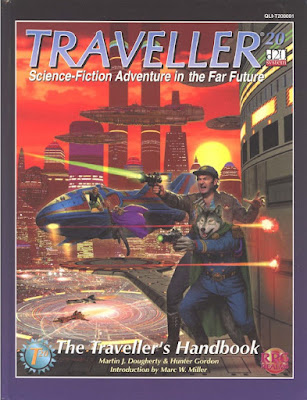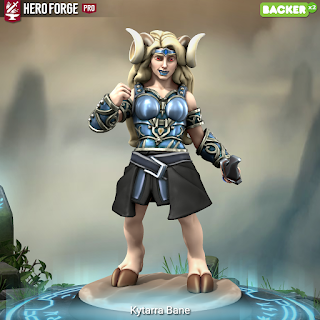I was talking to my oldest about my desire to maybe, just maybr running a d20 Dark•Matter game sometime. He laughed at me. I asked him why and he asked if I remembered what a a pain in the ass d20 Modern was at higher levels. Characters having at least three classes, feats all over the place, a recording nightmare. He was right, but undaunted I jumped in. I figure I'd create a few characters. I have three characters from my WitchCraft game that I'd love to get back too. Then there were two others from a Cinematic Unisystem game set in Chicago, brother and sister private eyes, that I always thought migth be fun to revist.
Yeah. That didn't work out really.
Now, to be fair, I am really, really out of practice building a d20 Modern Character, but damn I don't remember it being like this. In the end, I only did one (sorry, Scott and Heather) from my WitchCraft game.
While I set out to try to do a fairly straightforward translation of the Alternity material to d20, that also didn't work out really. So in the end I did a "spiritual translation" of Larina's Alternity Dark•Matter version to d20. They started out the same, but they drifted a bit apart.
I also could not find Scott's and Heather's sheets from my 1999 WitchCraft game, so at this point, I'd be basing them on their D&D alter egos, which may or may not be the best. Heather is a half-elf in D&D after all. I did find Eric MacAlister, Larina's ex-husband. But in truth, I never really did anything else with the guy after the 1999 game. She always worried that he would come after her, and he had kind of forgotten her. Plus, he was unable to fly post Sept. 11, 2001, due to all the restrictions.
So here is my witch. She took a long time to build here, and I am not 100% sure I got her correct.
Larina "Nix" Nichols
Human Charismatic Hero 5 / Mystic 7
Strength 8 (-1)
Dexterity 12 (+1)
Constitution 12 (+1)
Intelligence 17 (+3)
Wisdom 17 (+3)
Charisma 19 (+4)
Hit Points 66
Speed 30ft.
Defense 17, touch 17, flat 16
Init +1
Fort +9
Ref +8
Will +10
BaB/Grap +5 / +5
Melee/Ranged +5 / +6
AP 115 (lifetime)
Rep +7
Academic (starting occupation) University Librarian
Decipher Script
Knowledge (arcane lore)
Feats
Alertness
Attentive
Creative
Endurance
Educated (+2 on two knowledge skills)
Meticulous
Iron Will
Simple Weapon Proficiency [free]
Trustworthy
Toughness x1
Wild Talent (Psionic, Far Hand [TK])
Talents
Coordinate
Inspiration
Great Inspiration
Skills
| Skill Name | Key Ability |
Skill Modifier |
Ability Modifier |
Ranks | Misc. Modifier |
|---|---|---|---|---|---|
| Balance | Dex* | 1 = | +1 | ||
| Bluff | Cha | 12 = | +4 | +8 | |
| Climb | Str* | -1 = | -1 | ||
| Computer Use | Int | 6 = | +3 | +3 | |
| Concentration | Con | 9 = | +1 | +8 | |
| Craft (Structural) | Int | 3 = | +3 | ||
| Craft (Visual Art) | Int | 3 = | +3 | ||
| Craft (Writing) | Int | 3 = | +3 | ||
| Decipher Script | Int | 13 = | +3 | +10 | |
| Diplomacy | Cha | 16 = | +4 | +6 | +2 [bluff] +2 [Knowledge, history] +2 [trustworthy] |
| Disguise | Cha | 6 = | +4 | +2 | |
| Drive | Dex* | 1 = | +1 | ||
| Escape Artist | Dex* | 1 = | +1 | ||
| Forgery | Int | 5 = | +3 | +2 [meticulous] | |
| Gamble | Wis | 3 = | +3 | ||
| Gather Information | Cha | 6 = | +4 | +2 [trustworthy] | |
| Hide | Dex* | 1 = | +1 | ||
| Intimidate | Cha | 6 = | +4 | +2 [bluff] | |
| Jump | Str* | -1 = | -1 | ||
| Knowledge (arcane lore) | Int | 19 = | +3 | +14 | +1 [Academic] +1 |
| Knowledge (behavioral sciences) | Int | 9 = | +3 | +6 | |
| Knowledge (current events) | Int | 7 = | +3 | +4 | |
| Knowledge (earth & life sciences) | Int | 7 = | +3 | +4 | |
| Knowledge (history) | Int | 8 = | +3 | +5 | |
| Knowledge (popular culture) | Int | 5 = | +3 | +2 | |
| Knowledge (theology) | Int | 12 = | +3 | +8 | +1 |
| Listen | Wis | 9 = | +3 | +4 | +2 [alertness] |
| Move Silently | Dex* | 1 = | +1 | ||
| Navigate | Int | 3 = | +3 | ||
| Perform (Act) | Cha | 4 = | +4 | ||
| Perform (Dance) | Cha | 4 = | +4 | ||
| Perform (Keyboards) | Cha | 6 = | +4 | +2 | |
| Perform (Percussion) | Cha | 4 = | +4 | ||
| Perform (Sing) | Cha | 8 = | +4 | +4 | |
| Perform (Standup) | Cha | 4 = | +4 | ||
| Perform (String Inst.) | Cha | 4 = | +4 | ||
| Perform (Wind Inst.) | Cha | 8 = | +4 | +4 | |
| Research | Int | 10 = | +3 | +7 | |
| Ride | Dex | 1 = | +1 | ||
| Search | Int | 5 = | +3 | +2 [meticulous] | |
| Sense Motive | Wis | 5 = | +3 | +2 [attentive] | |
| Spellcraft | Int | 15 = | +3 | +10 | +2 [Knowledge, arcane] |
| Spot | Wis | 5 = | +3 | +2 [alertness] | |
| Survival | Wis | 3 = | +3 | ||
| Swim | Str** | -1 = | -1 | ||
| Treat Injury | Wis | 3 = | +3 |
Spells
0-Level
Detect Magical Aura, Haywire, Light, Mending, Read Magic
1st-Level
Bane, Cause Fear, Comprehend Languages, Instant Identify, Sanctuary, Trace Purge
2nd-Level
Augury, Darkness, Daylight, Hold Person, Shatter
3rd-Level
Bestow Curse, Dispel Magic, Magic Circle, Secret Pocket
4th-Level
Divination, Greater Magic Weapon, Via Negativa
Incantations
Bibliolalia, Cast into Shadow, Dedicate Site, Mystic Veil, Quartz Compulsion
Equipment
Knife [1d4, crit 19-20, range inc 10ft., 1lb., one-handed, piercing]
Taser [1d4 special, crit --, range 2ft., 3lb., electricity]
First Aid Kit [Treat Injury DC 15, one use, negates normal -4 to Treat Injury checks, 3lb.]
Vampire Slayer Kit [Mossberg, 5 wood stakes, 5 phos. shls, silver holy symbols, hand xbow, 5 wood bolts, metal mirror, garlic necklace, alum. case, 20lb.]
Business Clothing [3lb.]
Casual Clothing [2lb.]
Overcoat [3lb.]
Digital Camera [connects to computer, 0.5lb.]
Notebook Computer [5lb.]
PDA [connects with computer, 0.5lb.] Portable Occult Library
Total Weight Carried: 41lb. (medium load)
2005 Volkswagen Beetle (Purple) ARCANIX Illinois License Plates.
Larina NicholsHuman Female
Alignment: Independent (Agent of A.R.T.E.M.I.S.)
DoB: 10/25/1969 (36 in 2006)
Place of Birth: Carbondale, IL
Current Residence: Chicago, IL
Hair: Red
Eyes: Blue
Height: 5'4"
Weight: 127 lbs
Handiness: Right* (can write with Left hand, with difficulty)
Aliases: Larina MacAlister, Larina Nix, "Nixie."
So. This is a good build, I can't say I am 100% happy with it. There is so much customization you can do with d20 that the combinations and permutations are practically endless.
I both miss and hate, at the same time, d20's multiclassing. I love how flexible it is and how you can combine all sorts of classes to get the exact character you want. But it is also tedious. I mean I could have gone down the path of Occultist, or Acolyte, or even going into the various Prestige classes. There is so much choice.
I showed this to my son when he got off work Wednesday night/Thursday morning. He just laughed and reminded me yet again why we tend to play 5e, AD&D 1st ed and Basic D&D instead.
This exercise has also reminded me that I wanted to do a lot more with A.R.T.E.M.I.S. as well.





































